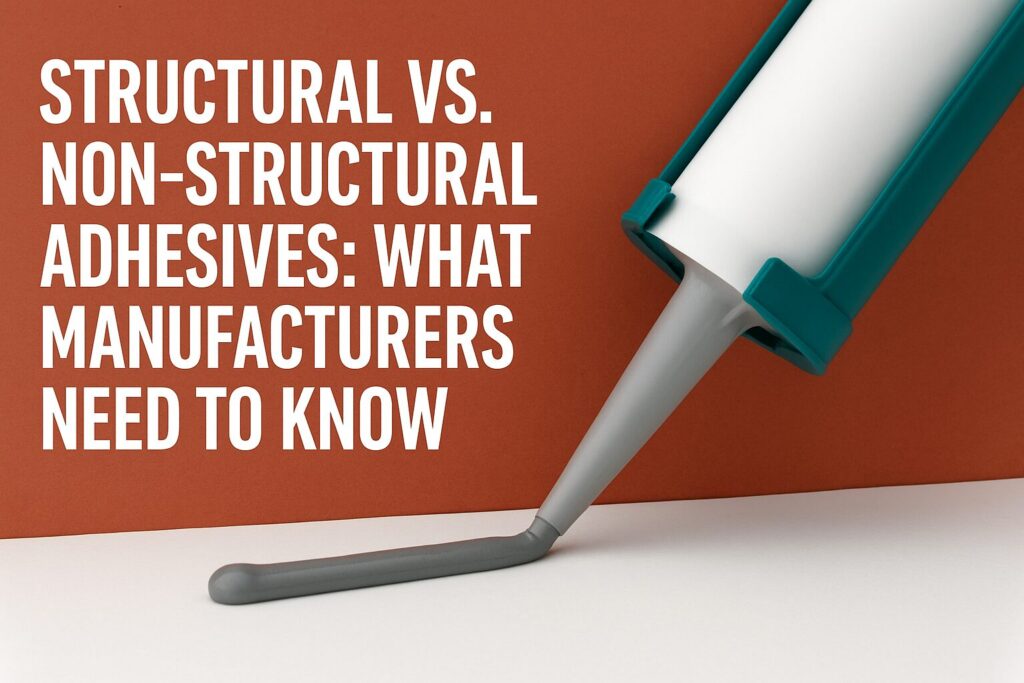Choosing the right adhesive isn’t just about bonding, it’s about ensuring performance, safety, and longevity across your product lifecycle. For manufacturers, especially in industries like automotive, aerospace, construction, and machinery, understanding the difference between structural and non-structural adhesives is critical.
What are both types of adhesives, their applications, pros and cons, and how to choose the right adhesive for industrial or commercial use, let’s find out.

What Are Structural Adhesives?
Structural adhesives are designed to form load-bearing joints. Once cured, they create strong bonds capable of withstanding high stress, shear, tension, and impact. These adhesives are often used in place of mechanical fasteners like bolts or welds, providing both strength and clean design.
Common materials they bond:
- Metals (steel, aluminum)
- Composites
- Wood
- Some plastics
Typical use cases:
- Automotive panels
- Machinery assemblies
- Aerospace components
- Metal fabrication
- Structural construction
GH1200 offers a range of high-shear structural adhesives engineered to perform under pressure, temperature, and vibration — ideal for manufacturers looking for durability and precision.
What Are Non-Structural Adhesives?
Non-structural adhesives are intended for light-duty bonding where load-bearing strength isn’t essential. These adhesives are still useful in industrial and commercial applications but are primarily chosen for ease of use, aesthetic finish, or temporary bonding.
Typical materials they bond:
- Fabrics
- Paper
- Lightweight plastics
- Rubber
- Foam
Common uses:
- Packaging
- Labeling
- Interior trim
- Crafting
- Decorative bonding
Products like adhesive putty or fabric adhesives fall into this category — perfect for non-load-bearing, flexible applications.
Key Differences: Structural vs. Non-Structural Adhesives
| Criteria | Structural Adhesives | Non-Structural Adhesives |
|---|---|---|
| Load-bearing | Yes | No |
| Strength | High shear, tensile, and peel strength | Low to moderate |
| Curing Time | Typically longer, requires specific conditions | Fast-curing or instant |
| Durability | Long-term performance in harsh environments | Short-term or aesthetic purposes |
| Common Types | Epoxies, urethanes, acrylics | Hot glue, PVA, cyanoacrylates, adhesive putties |
| Industries | Aerospace, Automotive, Construction, Manufacturing | Retail, Crafts, Packaging, Home Improvement |
Why Manufacturers Must Choose Wisely?
For manufacturers, adhesive failure can mean product recalls, safety hazards, and costly rework. That’s why using structural adhesives in load-bearing applications isn’t optional — it’s a quality control necessity.
Use Structural Adhesives When:
- Bonding components that carry loads or stress
- Replacing or reducing the need for mechanical fasteners
- Working in high-heat, impact-prone, or outdoor conditions
Examples:
- Epoxy glue gel for automotive frames
- Urethane adhesives in construction bonding
- Silicone adhesives for weatherproof assembly
Use Non-Structural Adhesives When:
- You need fast curing for small or temporary bonds
- You’re working with porous or soft materials like fabric or foam
- Structural strength isn’t a priority
Related Adhesive Types You Should Know
Consider these related adhesive types, each with specific industrial or consumer applications:
- Super glue gel – Fast-setting, good for lightweight precision bonds
- Cyanoacrylate adhesives – Ideal for quick repairs and surface bonding
- Thread locker gel – Prevents loosening of screws in high-vibration environments
- Automotive thread lock – Designed for vehicular use and high heat
Final Thoughts
Choosing between structural and non-structural adhesives depends on your application, load requirements, environment, and long-term durability goals. Misuse can lead to failure, while the right adhesive can enhance efficiency, aesthetics, and structural integrity.
That’s why at GH1200, we don’t just supply adhesives — we engineer solutions. Our experts work closely with manufacturers to ensure every product performs in the field as expected.
